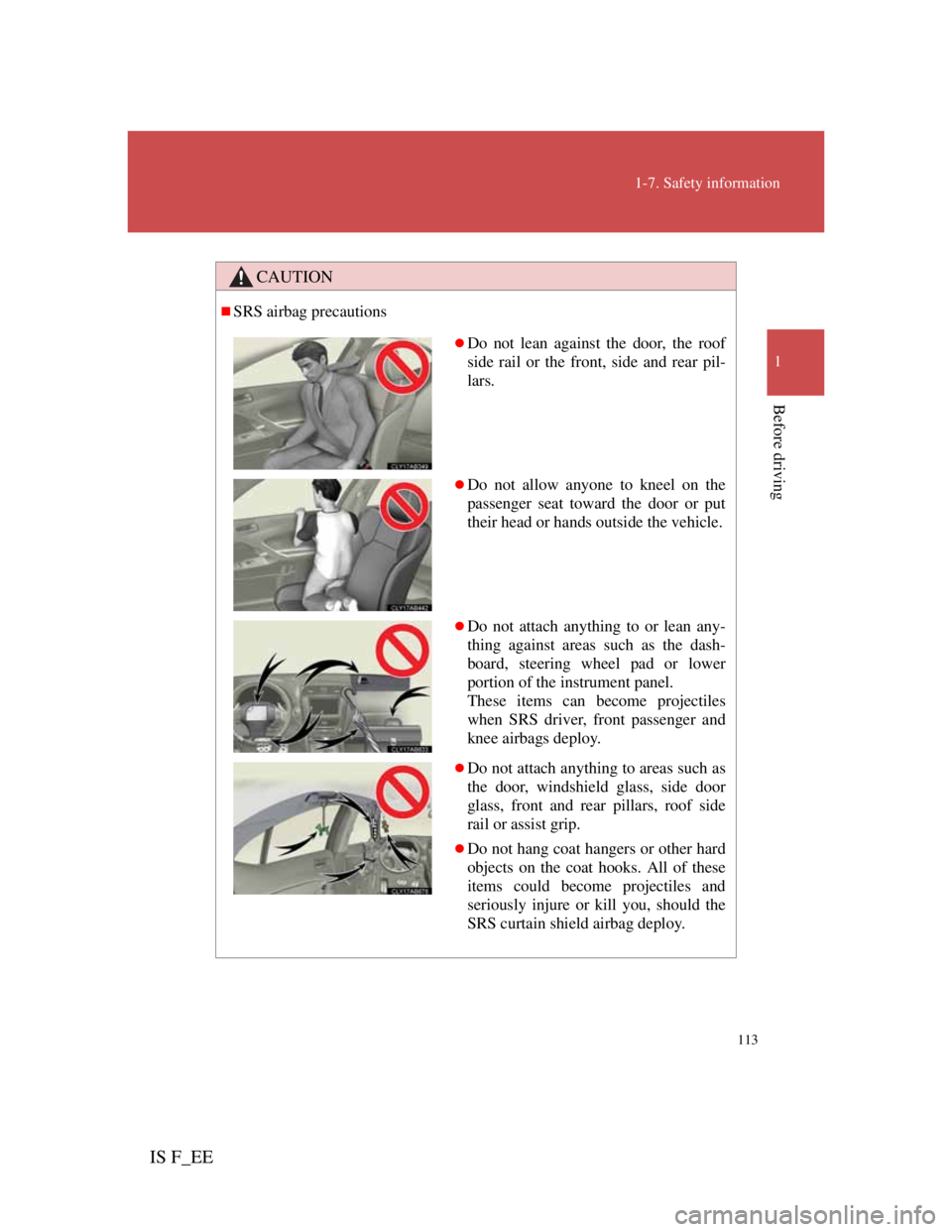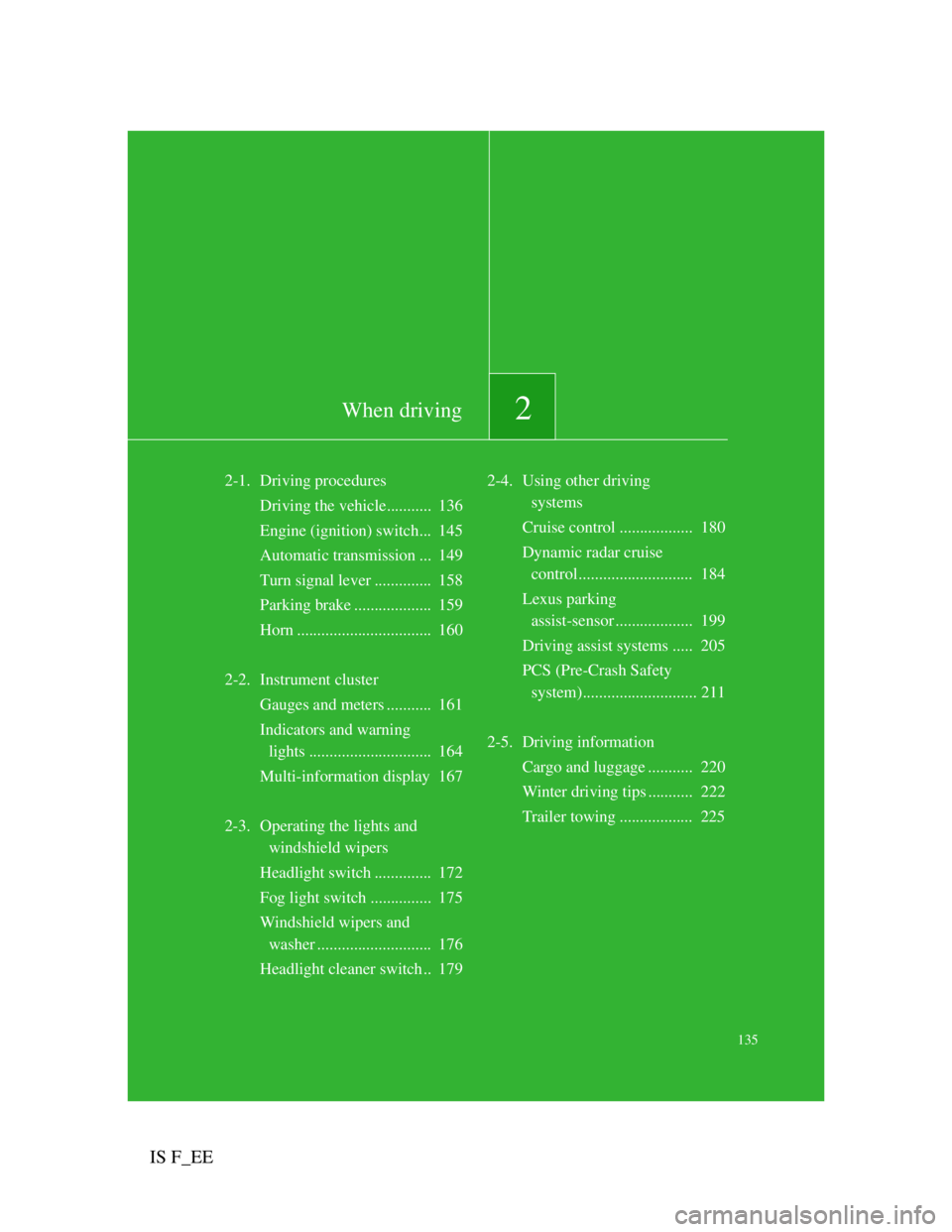tow Lexus IS F 2011 Owner's Manual
[x] Cancel search | Manufacturer: LEXUS, Model Year: 2011, Model line: IS F, Model: Lexus IS F 2011Pages: 529, PDF Size: 13.89 MB
Page 1 of 529

TABLE OF CONTENTS
IS F_EE
1
1Before drivingAdjusting and operating features such as door locks,
mirrors, and steering column.
2When drivingDriving, stopping and safe-driving information.
3Interior featuresAir conditioning and audio systems, as well as other in-
terior features for a comfortable driving experience.
4Maintenance and
careCleaning and protecting your vehicle, performing do-it-
yourself maintenance, and maintenance information.
5When trouble
arisesWhat to do if the vehicle needs to be towed, gets a flat
tire, or is involved in an accident.
6Vehicle specifica-
tionsDetailed vehicle information.
IndexAlphabetical listing of information contained in this
manual.
Page 3 of 529

1
2
3
4
5
6
IS F_EE
3
2-1. Driving procedures
Driving the vehicle ............. 136
Engine (ignition) switch ..... 145
Automatic transmission...... 149
Turn signal lever ................ 158
Parking brake ..................... 159
Horn ................................... 160
2-2. Instrument cluster
Gauges and meters ............. 161
Indicators and warning
lights................................. 164
Multi-information display .. 167
2-3. Operating the lights and
windshield wipers
Headlight switch ................ 172
Fog light switch.................. 175
Windshield wipers and
washer .............................. 176
Headlight cleaner switch .... 1792-4. Using other driving systems
Cruise control ..................... 180
Dynamic radar cruise
control .............................. 184
Lexus parking assist-sensor 199
Driving assist systems ........ 205
PCS (Pre-Crash Safety
system) ............................. 211
2-5. Driving information
Cargo and luggage ............. 220
Winter driving tips ............. 222
Trailer towing..................... 225
3-1. Using the air conditioning
system and defogger
Automatic air conditioning
system .............................. 228
Rear window and outside rear
view mirror defoggers ...... 236
Windshield wiper de-icer ... 237
2When driving
3Interior features
Page 6 of 529

TABLE OF CONTENTSIndex
IS F_EE
6
5-1. Essential information
Emergency flashers ............ 416
If your vehicle needs to be
towed ................................ 417
If you think something is
wrong ............................... 423
Fuel pump shut off system . 424
5-2. Steps to take in an emergency
If a warning light turns on
or a warning buzzer
sounds... .......................... 425
If a warning message is
displayed .......................... 431
If you have a flat tire .......... 444
If the engine will not start .. 454
If the shift lever cannot be
shifted from P................... 456
If you lose your keys .......... 457
If the electronic key does
not operate properly ......... 458
If the vehicle battery is
discharged ........................ 462
If your vehicle overheats .... 465
If the vehicle becomes
stuck ................................. 468
If your vehicle has to be
stopped in an emergency.. 4696-1. Specifications
Maintenance data
(fuel, oil level, etc.) .......... 472
Fuel information................. 482
6-2. Customization
Customizable features ........ 484
Abbreviation list ......................... 490
Alphabetical index ...................... 491
What to do if... ........................... 502
5When trouble arises6Vehicle specifications
Index
Page 44 of 529

41
1-2. Opening, closing and locking the doors and trunk
1
Before driving
IS F_EE
Operation signals
Doors: The emergency flashers flash to indicate that the doors have been
locked/unlocked. (Locked: Once; Unlocked: Twice)
Windows and moon roof: A buzzer sounds to indicate that the windows and
moon roof are operating.
Conditions affecting operation
The smart entry & start system uses weak radio waves. In the following sit-
uations, the communication between the electronic key and the vehicle may
be affected, preventing the smart entry & start system and wireless remote
control from operating properly:
(Ways of coping: P. 458)
When the electronic key battery is depleted
Near a TV tower, electric power plant, gas station, radio station, large
display, airport or other facility that generates strong radio waves or elec-
trical noise
When carrying a portable radio, cellular phone, cordless phone or other
wireless communication devices
When the electronic key is in contact with, or is covered by the follow-
ing metallic objects
• Cards to which aluminum foil is attached
• Cigarette boxes that have aluminum foil inside
• Metallic wallets or bags
• Coins
• Hand warmers made of metal
• Media such as CDs and DVDs
When multiple electronic keys are in the vicinity
When another wireless key (that emits radio waves) is being used nearby
When carrying or using the electronic key together with the following
devices that emit radio waves
• Another vehicle's electronic key or a wireless key that emits radio
waves
• Personal computer or personal digital assistant (PDA)
• Digital audio player
• Portable game system
If window tint with a metallic content or metallic objects are attached to
the rear window
Page 73 of 529

68
1-3. Adjustable components (seats, mirrors, steering wheel)
IS F_EE
Head restraints
Removing the head restraints (front seats)
Vertical adjustment (front
seats)
Up
Pull the head restraints up.
Down
Push the head restraint down
while pushing the lock
release button.
Folding operation (rear seats)
To stow the head restraint by
folding it forward, pull the
head restraint up while push-
ing the lock release button.
Only the button on the right
stay (when facing the front of
the vehicle) can be used to
Lock release but-
Lock release but-
Pull the head restraint up while pushing
the lock release button.
Page 74 of 529

69
1-3. Adjustable components (seats, mirrors, steering wheel)
1
Before driving
IS F_EE
Removing the head restraints (rear seats)
Adjusting the height of the head restraints
When using the rear seat head restraints
Make sure the head restraints are not in the stowed/folded position while in
use.
CAUTION
Head restraint precautions
Observe the following precautions regarding the head restraints. Failure to
do so may result in death or serious injury.
Use the head restraints designed for each respective seat.
Adjust the head restraints to the correct position at all times.
After adjusting the head restraints, push down on them and make sure
they are locked in position.
Do not drive with the head restraints removed.
Pull the head restraint up while pushing
both of the lock release buttons.
Lock release but-
Make sure that the head restraints are
adjusted so that the center of the head
restraint is closest to the top of your ears.
Page 81 of 529

76
1-3. Adjustable components (seats, mirrors, steering wheel)
IS F_EE
Steering wheel
Auto tilt away
When the “ENGINE START
STOP” switch is turned OFF,
the steering wheel returns to its
stowed position by moving up
and away to enable easier
driver entry and exit.
Switching to ACCESSORY or
IGNITION ON mode will
return the steering wheel to the
original position.
The steering wheel can be adjusted to a comfortable position.
Up
Down
Away from the driver
Toward the driver
Page 119 of 529

111
1-7. Safety information
1
Before driving
IS F_EE
CAUTION
SRS airbag precautions
Observe the following precautions regarding the airbags.
Failure to do so may cause death or serious injury.
The driver and all passengers in the vehicle must wear their seat belts
properly.
The SRS airbags are supplemental devices to be used with the seat belts.
The SRS driver airbag deploys with considerable force, and can cause
death or serious injury especially if the driver is very close to the airbag.
Since the risk zone for driver airbag is the first 50 - 75 mm (2 - 3 in.) of
inflation, placing yourself 250 mm (10 in.) from your driver airbag pro-
vides you with a clear margin of safety. This distance is measured from
the center of the steering wheel to your breastbone. If you sit less than 250
mm (10 in.) away now, you can change your driving position in several
ways:
• Move your seat to the rear as far as you can while still reaching the
pedals comfortably.
• Slightly recline the back of the seat.
Although vehicle designs vary, many drivers can achieve the 250 mm
(10 in.) distance, even with the driver seat all the way forward, simply
by reclining the back of the seat somewhat. If reclining the back of
your seat makes it hard to see the road, raise yourself by using a firm,
non-slippery cushion, or raise the seat if your vehicle has that feature.
• If your steering wheel is adjustable, tilt it downward. This points the
airbag toward your chest instead of your head and neck.
The seat should be adjusted as recommended above, while still maintain-
ing control of the foot pedals, steering wheel, and your view of the instru-
ment panel controls.
Page 121 of 529

113
1-7. Safety information
1
Before driving
IS F_EE
CAUTION
SRS airbag precautions
Do not lean against the door, the roof
side rail or the front, side and rear pil-
lars.
Do not allow anyone to kneel on the
passenger seat toward the door or put
their head or hands outside the vehicle.
Do not attach anything to or lean any-
thing against areas such as the dash-
board, steering wheel pad or lower
portion of the instrument panel.
These items can become projectiles
when SRS driver, front passenger and
knee airbags deploy.
Do not attach anything to areas such as
the door, windshield glass, side door
glass, front and rear pillars, roof side
rail or assist grip.
Do not hang coat hangers or other hard
objects on the coat hooks. All of these
items could become projectiles and
seriously injure or kill you, should the
SRS curtain shield airbag deploy.
Page 145 of 529

2When driving
135
IS F_EE
2-1. Driving procedures
Driving the vehicle........... 136
Engine (ignition) switch... 145
Automatic transmission ... 149
Turn signal lever .............. 158
Parking brake ................... 159
Horn ................................. 160
2-2. Instrument cluster
Gauges and meters ........... 161
Indicators and warning
lights .............................. 164
Multi-information display 167
2-3. Operating the lights and
windshield wipers
Headlight switch.............. 172
Fog light switch ............... 175
Windshield wipers and
washer ............................ 176
Headlight cleaner switch .. 1792-4. Using other driving
systems
Cruise control .................. 180
Dynamic radar cruise
control ............................ 184
Lexus parking
assist-sensor ................... 199
Driving assist systems ..... 205
PCS (Pre-Crash Safety
system)............................ 211
2-5. Driving information
Cargo and luggage ........... 220
Winter driving tips ........... 222
Trailer towing .................. 225